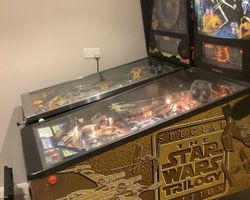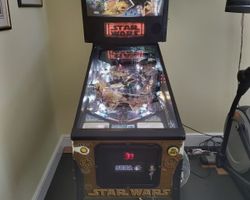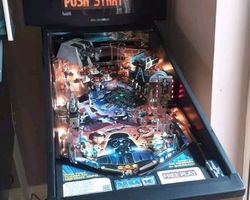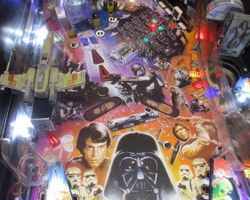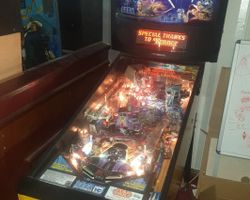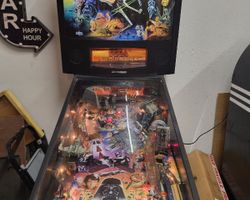Star Wars Trilogy
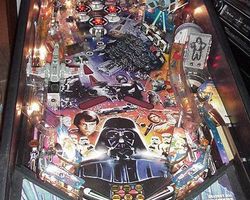
Average Prices: USD $1,200 to $3,400
Produced: March, 1997
Machine Type: Solid State Electronic
MPU: Sega/Stern Whitestar
Players: 6
Design by: Joe Kaminkow, Joe Balcer
Art by: Morgan Weistling, Marc Raneses
Dots/Animation by: Marc Raneses
Music by: Brian Schmidt
Sound by: Brian Schmidt
Software by: Orin Day, Lonnie D. Ropp
Sega Pinball, Inc. entered the galactic fray in March 1997 with the release of Star Wars Trilogy, a pinball machine designed to capture the excitement of the original cinematic saga. Timed to coincide with the theatrical re-release of the Special Editions of A New Hope, The Empire Strikes Back, and Return of the Jedi, the game aimed to leverage renewed public interest in the franchise. Manufactured under the Sega Pinball banner, which had emerged following Sega's acquisition of Data East Pinball, this machine utilized the Sega/Stern Whitestar board system, a platform shared with several other titles from that era.
The design effort was spearheaded by Joe Balcer and Joe Kaminkow, with programming duties handled by Lonnie D. Ropp and Orin Day. A key contributor was artist Morgan Weistling, responsible for the striking backglass and playfield artwork that vividly depicts scenes and characters from the three films. Brian Schmidt composed the music and sound effects, incorporating John Williams' iconic score elements to enhance the thematic immersion. With a production run of approximately 2,250 units, Star Wars Trilogy found its way into arcades and home collections, offering a distinct pinball interpretation of the beloved space opera. An interesting footnote in its history involves a purported "Collector's Edition" mentioned by programmer Orin Day as being sold through the Neiman Marcus catalog, though details and quantities remain scarce, adding a layer of intrigue to its production history. The machine's official full title, The Star Wars Trilogy Special Edition, appears on cabinet sides and documentation, while the more concise Star Wars is often seen on the backglass and playfield.
Signature Features and Design
Star Wars Trilogy distinguishes itself with several prominent interactive elements and toys designed to bring the Star Wars universe to life on the playfield. Perhaps the most notable is the X-Wing fighter mechanism. Positioned on the left side, this model ship pivots and, when activated by the player, fires the pinball across the playfield towards a target representing a TIE Fighter. This interactive sequence is not merely decorative; it's integral to starting one of the game's multiball modes and provides a satisfying kinetic payoff.
Complementing the X-Wing is the TIE Fighter toy itself, situated near the top right. More than just a static model, this TIE Fighter shakes and rattles when hit, providing visual and tactile feedback. Another significant feature is the representation of the Death Star's laser cannons, often referred to as the "Laser Turret," which ties into specific shots and objectives within the game rules.
Visually, Morgan Weistling's artwork is a defining characteristic. The backglass presents a montage of key moments and characters, while the playfield art weaves thematic elements around the various shots and features. The overall aesthetic aims for a direct translation of the films' visual language onto the pinball medium. These signature features collectively aim to create an engaging experience, leveraging recognizable Star Wars iconography through interactive playfield elements.
Playfield and Mechanics
The Star Wars Trilogy playfield presents a relatively open design, dominated by a central ramp and specific key shots tied to the main features. It utilizes a standard two-flipper layout at the bottom. Above the flippers are the typical slingshots, flanking the inlanes and outlanes. Central to the lower playfield is a four-bank of drop targets, crucial for progressing towards certain objectives.
Moving up the playfield, the most prominent feature is the large central ramp. This shot is vital for spelling "FALCON" and initiating the Millennium Falcon 4-ball multiball mode. To the left of the ramp entrance sits the X-Wing fighter assembly. Players shoot a specific lane to load the X-Wing, then use a cabinet-mounted "buy-in" button (also serving as the launch button) to fire the ball from the X-Wing across the playfield towards the TIE Fighter target located on the upper right.
Near the TIE Fighter target are four pop bumpers, clustered to generate chaotic ball action in that zone. Various stand-up targets and rollovers are positioned around the playfield, contributing to scoring and mode progression. The overall layout encourages shots towards the upper sections, particularly the ramp and the TIE Fighter target via the X-Wing.
The design philosophy appears geared towards accessibility, with major features being relatively easy to understand and shoot for. The flow can be fast-paced, particularly when the ball is interacting with the pop bumpers or during multiball, though the open nature of the lower playfield can sometimes lead to quicker drains if ball control falters. The artwork by Weistling covers the playfield surface, depicting scenes like the Battle of Hoth and the Millennium Falcon navigating an asteroid field, reinforcing the theme. Lighting, including flash lamps and the Dot Matrix Display (DMD) animations created by Marc Raneses, complements the action, signaling mode starts, jackpots, and story progression. The automatic plunger launches the ball into play, starting the journey through the trilogy's key moments.
Gameplay Dynamics
The gameplay of Star Wars Trilogy revolves around completing modes based on iconic scenes and achieving multiball events. Players progress primarily by making specific shots repeatedly or completing target banks. The ruleset is generally considered straightforward compared to some deeper contemporary machines.
Key objectives include:
- TIE Fighter Multiball: Initiated by hitting the TIE Fighter target enough times, often requiring skillful use of the X-Wing cannon mechanism. Successfully "shooting down" the TIE Fighter starts a 3-ball multiball sequence where specific shots score jackpots.
- Millennium Falcon Multiball: Achieved by repeatedly shooting the main ramp to spell F-A-L-C-O-N. This triggers a 4-ball multiball, offering high-scoring opportunities.
- Heroic Specialty Shot Sequences: The game features modes inspired by moments from the films, such as escaping the Death Star or confronting Darth Vader. These often involve hitting designated shots within a time limit or in a specific order.
- Han Solo Trivia: Completing the 4-bank drop targets can initiate a mode where players answer trivia questions about the Star Wars saga via the flipper buttons, themed around thawing Han Solo from carbonite. Correct answers yield point rewards.
- Hurry-Up Challenges: Timed modes that require players to quickly hit a specific target for increasing point values.
- Video Mode: A mini-game displayed on the DMD, offering a break from the physical pinball action and a chance for bonus points, typically involving piloting a ship or targeting enemies.
Scoring relies heavily on completing these modes and capitalizing on the multiball rounds. Jackpots during multiball are often the primary path to high scores. The relatively simple rules allow players to quickly grasp the main objectives: shoot the ramp, shoot the TIE Fighter (often via the X-Wing), and complete the drop targets. While not offering intricate layers of stacking or complex mode progression found in some other machines, the gameplay focuses on achieving recognizable goals tied directly to the Star Wars theme, emphasizing action and major multiball events. Player strategy often involves prioritizing either the ramp shots for Falcon Multiball or mastering the X-Wing shot to initiate TIE Fighter Multiball, then maximizing points during those chaotic sessions.
Reception and Legacy
Upon release and in the years since, Sega's Star Wars Trilogy has garnered a notably polarized reception within the pinball community. It remains a divisive title, with passionate defenders and equally vocal detractors.
Strengths frequently highlighted by players include:
- Theme Integration: For fans of the original Star Wars trilogy, the machine effectively leverages the license with recognizable sounds, music snippets, artwork, and thematic modes. The use of actual film assets (audio and visual inspiration) is often praised.
- Engaging Toys: The X-Wing cannon mechanism is commonly cited as a fun and unique feature, providing a satisfying interactive element. The shaking TIE Fighter also adds kinetic appeal.
- Accessibility: The straightforward ruleset makes the game relatively easy to understand and play, appealing to casual players or those less familiar with complex pinball strategies.
- Nostalgia Factor: The machine taps directly into the nostalgia associated with the original films, particularly relevant during its release alongside the Special Editions.
However, significant criticisms are also frequently leveled against the game:
- Gameplay Depth and Flow: Many experienced players find the ruleset shallow and repetitive. The gameplay is sometimes described as "clunky" or lacking smooth shot combinations. The open nature of the playfield is seen by some as uninspired or leading to frustrating drains.
- Sound Quality: While the thematic sounds are present, the original hardware's audio output is often criticized as tinny or subpar, detracting from the experience unless upgraded.
- Build Quality Concerns: Some owners report issues with the reliability of certain components or perceive the overall build quality as less robust compared to machines from manufacturers like Williams/Bally during their peak.
- Artwork Execution: While Weistling's art is generally acknowledged, the execution of the cabinet art is sometimes viewed as bland or less dynamic compared to the playfield and backglass.
In terms of legacy, Star Wars Trilogy holds a specific place as Sega Pinball's interpretation of the franchise during the late 1990s. It is often compared, sometimes unfavorably, to the earlier Star Wars pinball machine released by Data East (Sega's predecessor). Its reputation remains that of a game heavily reliant on its theme, with gameplay that clicks for some but falls short for others. It didn't establish major innovations that significantly influenced subsequent pinball design, but it stands as a notable example of a licensed theme implementation on the Sega/Stern Whitestar platform, representing a particular moment in pinball history where leveraging major intellectual property was a key market strategy. Its continued presence in collections and arcades speaks to the enduring appeal of the Star Wars license and the unique, if debated, experience it offers.
 Active Auctions
Active Auctions
 Auction Results
Auction Results
| Cost | Location | Date |
|---|---|---|
| USD $5,500 |  Arizona, United States Arizona, United States |
27 March, 2025 |
| GBP £3,832 |  United Kingdom United Kingdom |
10 February, 2025 |
| USD $3,500 |  Oklahoma, United States Oklahoma, United States |
26 October, 2024 |
| GBP £2,802 |  United Kingdom United Kingdom |
16 September, 2024 |
| USD $4,100 |  Ohio, United States Ohio, United States |
02 December, 2023 |
| USD $5,899 |  United States United States |
04 November, 2023 |
| GBP £3,300 |  Glasgow, United Kingdom Glasgow, United Kingdom |
13 July, 2023 |
| GBP £3,695 |  Lytham, United Kingdom Lytham, United Kingdom |
20 June, 2023 |
| GBP £3,175 |  Nuneaton, United Kingdom Nuneaton, United Kingdom |
07 December, 2022 |
| GBP £2,839 |  Melton Mowbray, United Kingdom Melton Mowbray, United Kingdom |
21 August, 2022 |


Private Policy · Search Website · Contact Us
All trademarks and copyrighted materials remain property of their respective owners.
All other content copyright 2007 - 2025 Pinpedia.

